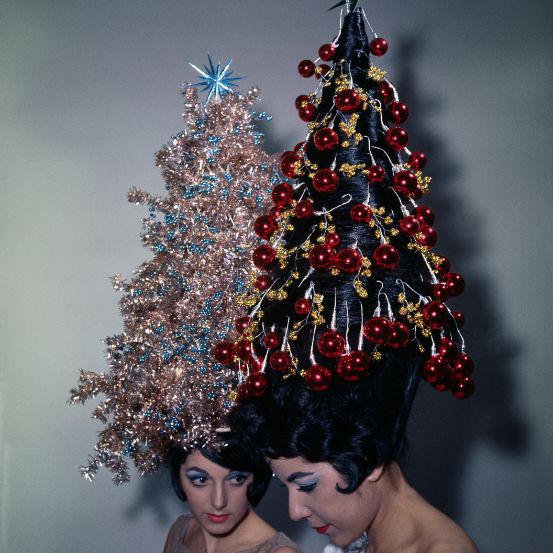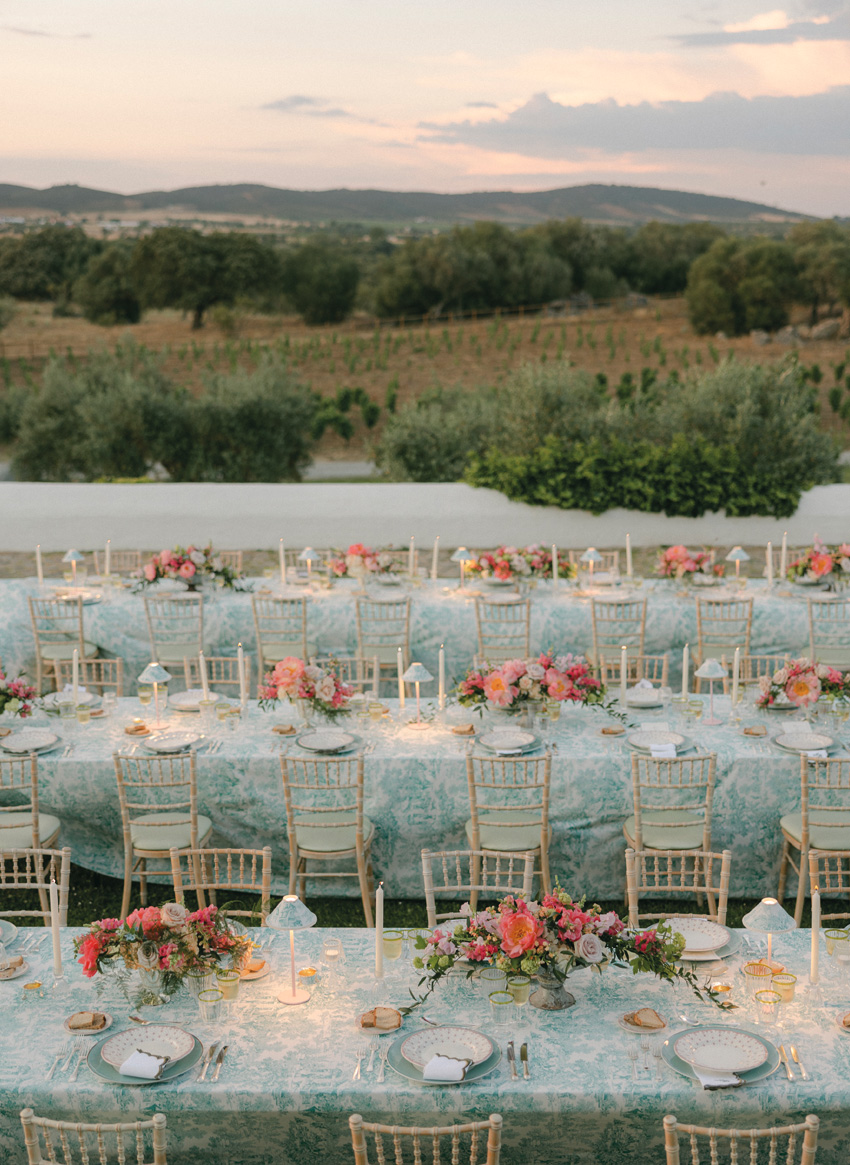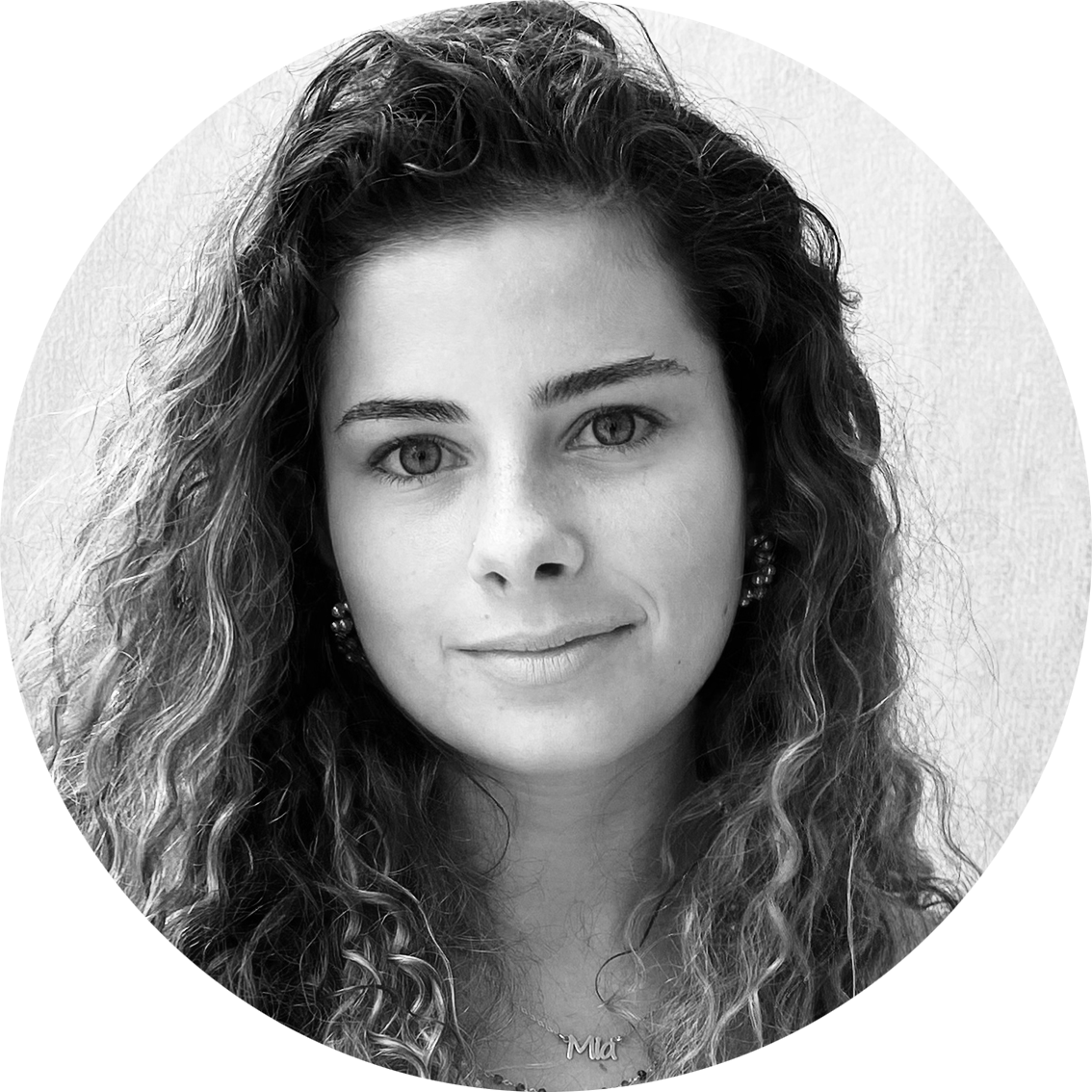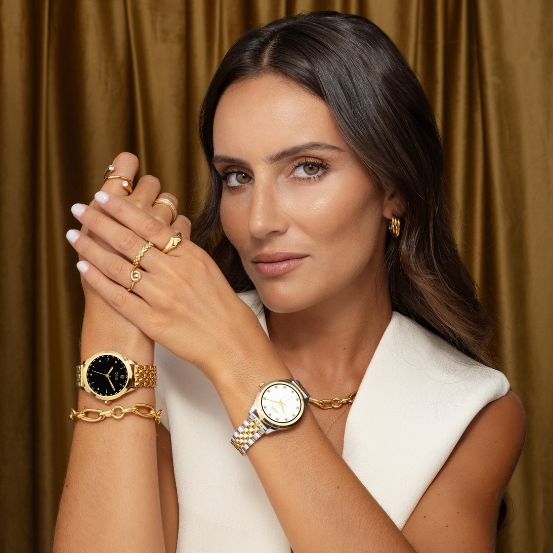Holly Clark
Jasmine Lazzari arrived in Portugal in 2000, and after years of working with luxury brands, she embarked on an ambitious project: creating absolutely idyllic weddings for brides and grooms with very high expectations. The wedding and event planner is dedicated to creating memorable moments that are the starting point for "and they lived happily ever after". In this interview, she tells us how she does it - while also revealing some precious advice for those who are getting married soon.
She studied music in London, but it was in the world of events - especially creating exceptional weddings - that she built a renowned career. Jasmine Lazzari tells us that being a wedding planner is akin to being a maestra, creating perfectly orchestrated weddings, in a symphony where all the notes coexist harmoniously. Before that, Lazzari worked for a number of agencies working with luxury brands in London and Lisbon (from Hermès to Burberry or Cartier), where she learned everything about the market. Later, decided to create a project of her own, without overlapping with what already existed here. And that's when she realized that there was a huge gap in the country: "There was no company with an international profile to create what are now called 'destination weddings', weddings for people who don't live in Portugal, who have an excellent budget and want to get married in a palace or somewhere else in Portugal."
Jasmine Lazzari's first big event was for a client from the United States, who had a private house in Évora and inaugurated the estate with an equestrian show. Around here, it was thought that the event had been planned by a New York company because there was no one in Portugal with that kind of eye. It was Lazzari's background, having international experience and coming from a less traditional society, that gave her a broader view of what clients in New York, Los Angeles or London expected - and with this different perspective, she started The Wedding Co. "I'm a pioneer in the area, and I'm the first luxury wedding planner in Portugal," responsible for creating many weddings for Portuguese mannequins, public figures and Hollywood stars. "I've always been focused on putting Portugal on the map, as Italy is, or as the South of France will always be. Portugal is growing immensely. We now have a huge community of wedding planners, mainly women, which makes me very happy," she tells us on a sunny February morning, between a table full of spectacular wedding invitations and a collection of coffee table books capable of making anyone envious. "Portugal is geographically in an easily accessible position, it's a bit unknown [...] I think it's appealing for someone to come here and enter a 17th or 18th century palace, with a garden - there always has to be a garden." It's the essence of "old-world elegance" that seeks sumptuous, antique luxury. And what attracts her most is "doing weddings in a beautiful place." The bride and groom "want palaces, they want beautiful things. The tiles and the heritage, it's all very important."
The Wedding Co. - which will soon become an eponymous brand because it is growing, with collections of tableware with Vista Alegre, for example - was born in 2007. There are five key members of the team: Jasmine, Marta, the senior event producer who "deals with suppliers, collecting all the information and managing production", Paulo, "who deals with all the logistics and transport" and, when it comes to the actual wedding day, a team she has worked with for over ten years: Teresa takes care of the bride and the details of the day, and Luís does all the production. These are five precious elements, in addition to all the others who make the event happen, such as the hosts: "We've never had people at weddings who didn't know where something was, such as the toilets. We never have dead moments, we never have a person without a glass in their hand, without water, wine or juice. It's a party. We can't cancel out anyone's experience." "It's a close-knit team that leaves nothing to chance: "We all work together [...] There are no hierarchies, no divisions." But it's long before the big day that the team gets to work, so that guests and the bride and groom don't have to worry about anything from the moment they set foot on Portuguese soil: "We have drivers to pick them up, we have goodie bags with, of course, pastéis de nata, waters, Port wine, soaps... Portuguese treats. It's a way of presenting Portugal." The experience comes down to the way they make guests feel, "the care, the attention. Feeling that they have someone here who cares about them, that everything is tailor-made. They have to feel special."
Being a wedding planner is no easy task, and the challenge increases when it comes to brides and grooms who "have been to many beautiful weddings, on Lake Como, for example. They are people who travel a lot, who have been to a lot of parties, people who have a very busy life. What do they want? Good service - either from us or from the person serving the food. So our concern is always to meet expectations and that people aren't disappointed, that everything goes according to plan like in the trials." And there are elements that can be the make or break of a ceremony, she explains: "I don't think anyone realizes that lighting and sound weigh heavily on the total budget. Having a band costs a lot, especially since there are no bands in Portugal with the image we're looking for [...] we have to ask them to come from elsewhere, most of the time from London. And that makes it expensive. The platform, the lights, the backstage, there are a lot of elements."
In addition, the wedding planner places enormous emphasis on the lighting of spaces and tells us that if there's one element she'd like to make clear, it's the colossal difference that lights make at an event: never white lights, always yellowish, soft lights, and even candles to create the perfect atmosphere: "You have to lower everything, you don't need a lot of light at dinner, we use candles. It immediately changes the atmosphere. Light changes spaces, you can't have the same atmosphere everywhere." Make a note: soft lighting and sound control. "We would never have speakers next to the bride and groom," for example.
Lazzari's concerns center on balancing the expectations of the bride and groom with the real possibilities - and, it should be noted, here we are talking about a reality that is very close to an authentic fairy tale. "I feel that as a company we get very involved with couples, and there are few people who do, perhaps because they do more weddings. We're not a wedding factory, we do very few weddings and we're very close to the bride and groom and their families." After all, this is, in her words, "a huge responsibility", both because this will most likely be one of the happiest days of the bride and groom's lives and because the logistics can be challenging. Nothing can fail, and this requires a lot of time: "The project sometimes takes a year and a half. Producing something that is the fruit of a dream is incredible. And the experience of the bride and groom, seeing them happy on the day, is fantastic. The most challenging part is conveying to the suppliers the level of quality we have to maintain. I'm very strict with the quality plan, with myself, with the bride and groom, with the team. That's why I'm hired by these types of people and I take it very seriously, but also with a sense of lightness."
Naturally, not everything goes according to plan but, as Jasmine puts it, "it's not usually the end of the world, because we always have the welcome dinner [to gather the guests]. Traffic can be a problem. We once had a fantastic wedding in Sintra. It started in Lisbon, the bride and groom were from Los Angeles, and they came with a Jesuit priest. The first night was at the Palácio Chiado, then they had dinner in Lapa and Paulo brought all the luggage, and then the people headed to the church of Santa Maria in Sintra, where the wedding was to take place. That day there was a hurricane, and when the bride left, a tree fell in the street, so there was a 40-minute delay [...] The unforeseen doesn't depend on us, but it depends on us to make it quicker: we have music, and staff who are always ready to help." There's always a plan B, even in the event of rain: sometimes, "the bride and groom don't want to admit that it's going to keep raining. It's almost like going into shock. So [the secret] is a bit about how we deal with it, and having fantastic teams to change it."
Although the circumstances are sometimes challenging, Lazzari confesses that she hasn't come across a real bridezilla: "This is a big industry and it's common to [focus on] the bride's experience, as we see on Instagram: the shape, the poses, the clothes, influence a person a lot. I feel that brides have higher expectations, they see their image in public a lot. Ten years ago the concern with image wasn't so strong. This is a very important element, so we have to choose well who we hire: the photographer, the make-up artist, the hairdresser. We have to be aware of who we're dealing with and their expectations. I've had a few situations, but I wouldn't say they're bridezillas. We're very organized, and we have a lot of communication, it's essential for us. Not communicating with brides is the worst thing you can do." In fact, as opposed to bridezillas, the brides Jasmine works with are often eccentric and fun, she tells us, recalling a wedding she organized at the Marquês de Fronteira Palace where "[the bride and groom] wanted a tiger. We said we couldn't do that, everyone would be scared and no one would want to work. So we had a two-meter embalmed tiger that came from Spain, and we had peacocks. That was the wedding. The bride's nickname was 'Bunny', so I had some bunnies made with her name on. It was very nice, and it was a remarkable wedding because it was different and unexpected."
But let's move on to the doubts and concerns that worry the couple. "The first thing to do when you get engaged is to find out how many people you want at the wedding. I always say to Portuguese brides and grooms, 'it's not a funeral, we don't have to invite everyone we know'." Jasmine Lazzari makes this point very clear, but also offers suggestions: "Why not invite the work colleague [who you like but aren't that close to] just for the dance floor? It's the same with children: I love children, they're wonderful, and they should be in the church, but then they should go home, because a child only takes away from the bride's visibility. There isn't a child in the world who doesn't get upset later, who starts crying, and nobody can control that." And how to address this issue? In the invitation, by saying "children are welcome, even at the reception", for example. "Everything is in the invitation, like the dress code, which is very important. We have to dress elegantly: there are colors that shouldn't be worn. For example, red is very strong in the image. And there's always a woman wearing a red or cream dress. It's annoying. These are small things, but they are important." In addition, she recommends making it clear, if you so wish, that it is not allowed to take images with a phone during the ceremony - it could spoil the moment and, moreover, there is always a team of photographers whose job it is to make these exact images.
Regarding gifts and bank transfers, the approach to be taken on the invitation is very simple: "We've already had this at a very formal wedding and on the invitation it said 'here is the NIB' in calligraphy. Very simple. And everything looks prettier in calligraphy, of course [laughs]." And, since we're talking so much about invitations, how far in advance should they be sent? "The save the date is very important, it can be done as soon as you have the date. The invitation can be sent about three months before, and it should come with lots of instructions, and the 'how to get there'. You don't want people calling to ask for directions. Not everyone uses technology in the same way, so you need to make everything very clear and traditional. Some people need to have a website because it involves travel, accommodation and transportation. Timing is very important." In fact, along with lighting and sound, timing is another crucial factor in the success of an event: "Where is the ceremony and where is the reception? Do we have to travel, do we have transportation, how long does it take? You have to record things. You need a timeline."
Logistics are crucial, from timings to photographs, and everything has to be planned: "If the bride and groom want traditional photographs, then we have the team to take care of that, and they say 'brothers here, grandparents here', but it has to be quick." And for those who don't have this kind of team at their disposal, Jasmine Lazzari suggests "online wedding planning tools" that can be downloaded, or, on the other hand, finding a family member who is organized to coordinate these moments. As for the time, the perfect time to start the ceremony depends on whether it's religious or not, but the maximum duration of a wedding should be twelve hours. Personally, reveals, she would never have a wedding at midday, because the light is too high and it can be too hot. The cocktail should not exceed an hour and a half and the ideal time to start dinner is during sunset. A tip: for those who find the cake moment awkward, have it immediately after the ceremony: it's ideal for breaking the ice and you'll be "done in no time."
As far as aesthetics are concerned - undoubtedly one of the most important points - everything has to be thought out according to the tastes of the bride and groom, but looking at the decoration as a way of reflecting the "old-world elegance" that Jasmine emphasizes so much, rather than thinking about trends. "It's better to have less but good, than too much and bad. You also have to think about the room, what it looks like. For example, a room with only candles is very elegant and very beautiful. But is there air conditioning in that room? Because it will become very hot. [...] We see a lot of pictures on Instagram with no context. [...] Don't ruin the aesthetics of the table for one thing. Don't think too much about trends, think about what you like. In my opinion, a wedding should be more or less timeless," although that doesn't mean boring or discreet: "I've done a wedding with a purple tablecloth and green chairs, my own wedding was anything but timeless, and it doesn't necessarily have to be. But a timeless wedding can be reflected in the images." The color, the light, the atmosphere; everything contributes to the harmony of the space and having a well-composed table "has several layers": we never want a copy, but rather something that reflects the personality of the bride and groom. In addition, it's important to "invest in seasonal flowers [...], it has to be a flower that's beautiful at the time and [preferably] with a big, beautiful head, not something closed." It's important to have well-defined ideas and inspirations, and not to give in to passing trends: "There are trendy images that I don't think are suitable for a wedding, like blurry. Black and white is beautiful and very elegant, but color gives a lot of life - and a photographer has to have many years of work to know how to do that."
As well as mistakes in photography, another major flaw is not making the table plan in advance: "Our contract says that the table plan has to be finished - mainly because our guests are from abroad - eight days before the event. It's the hardest thing to do. [...] It's the only thing we can't organize. But it falls under our responsibility, because on the day, seating people is our responsibility." And Jasmine, here, is in favor of contradicting tradition by being able to separate the couples at the tables: "I've been to a wedding, many years ago, as a guest, of a typically Portuguese family, a very large one, and I remember that the father stayed at one table and the mother at another, leading each table. I think you have to mix people up, [bearing in mind that] you can't have an introverted person next to someone you don't know." Something she also stresses is the importance of the meal not lasting forever and not having dozens of dishes (also to avoid waste): "Nobody wants to be at the table for too long [...]. That never happens at our weddings [....] Usually, at the opening, people sit down and others make speeches - don't give that up, it's interesting, beautiful, personal. It's a nice way of saying thank you to people. It's delicate and polite." But then the bride and groom can be served first, and then the different tables can be served as they finish the dish. "It's not a banquet, it's not a state dinner. Of course everyone wants to have dinner, but it's in an hour and a half." In addition, the bride and groom don't need to go around all the tables and greet the guests: it's "old fashioned" and will slow down the process more.
Jasmine Lazzari's final pieces of advice include "being aware of the market, the suppliers, and that what's on Instagram might not be reality." And it's crucial to follow her recommendations: "It's very important to listen and think 'I'm going to leave this project to the professionals, I'm going to hire you and you take care of me, my family and my guests. Also, just have fun and take it as a journey. None of this is pre-formatted." Finally, the wedding planner stresses the importance of the bride and groom taking a moment for themselves in between the hectic schedule: "Personal, intimate time for the bride and groom on the day is really important, [...] you notice and the day is over. I always say that to the bride: 'This is the moment, now'."
Relacionados





.jpg)

.jpg)


